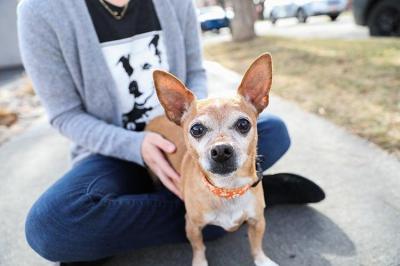
FAQs About Small Dogs as Pets
If you're new to small dogs, you might wonder whether there are differences in caring for them because of their size. All dogs are individuals, of course. But there are some considerations to keep in mind when bringing home a small dog. Here are some frequently asked questions about these petite pups.
What is small dog syndrome?
Small dog syndrome is a stereotypical term referring to when a small dog is especially reactive or feisty (seemingly compensating for their small stature) and displays undesirable behaviors, such as jumping on people or nipping.
A common mistake some people make with small dogs is disregarding their emotional state and undesirable behaviors. Many small dogs learn that people ignore their early warning signs, which forces them to escalate their behavior to stop something from happening that they don’t like. For example, people might disregard a small dog growling because they're not threatened by the dog's petite stature, so the dog escalates to biting.
So if you have a feisty little Fido, don’t laugh it off. Your pup is trying to communicate something to you. Barking, growling, and lunging on leash may be easier to manage with a 10-pound dog as opposed to a 100-pound giant, but the message is still the same: The dog is not comfortable with what’s going on at the moment.
Do small dogs like to be held?
A critical aspect of understanding your dog (big or small) is educating yourself on dog body language, so you can recognize the early signs of stress. Subtle signals are often missed. A stressed dog might yawn, pant heavily, or lick their lips frequently. Some dogs roll over on their backs when scared — an attempt to convey the message, “I’m not a threat, so please give me space.”
Home starts with you
Many little dogs will tolerate a lot of handling, even when they aren’t enjoying it. To see whether your dog actually wants to be petted and what they like best, you can perform a “consent test.” Give your dog a little scratch under the chin or on the chest; do that just for a few seconds and then stop.
Does your dog solicit more touch? Great! Give them a little more love and watch how they react. Take frequent breaks, so your dog can decide when they've had enough. Try different kinds of brief petting and handling. You’ll be able to tell by how the dog engages with you whether they enjoy it.
As a side note: Not all dogs appreciate wearing clothes. While your tiny pup might benefit from donning a sweater in cold weather, pay attention to their body language when playing dress-up. If your dog isn’t having fun, why do it? It will only add stress to their life, and stress can build up over time. If your dog needs clothing for warmth and balks at wearing a sweater, find a less invasive option, such as a wrap jacket.
What is the best training for small dogs?
The same compassionate training approaches used for big dogs work for little ones. You’ll need to identify your dog’s triggers: What causes them to whine, growl, or bark? You’ll also need to know what high-value treats your dog loves to reward desirable behaviors. You’ll use that knowledge when you teach your dog training cues and behaviors.
When training any dog, keep the treats tiny; your dog shouldn’t have to chew more than once or twice before swallowing. You’ll also need to consider how much your dog eats during training when portioning out their regular meals. Depending on your training program, you might end up using your dog’s regular food as treats and forgo the bowl altogether.
Keeping a healthy weight is important with all dogs, but it’s easy to go overboard when your dog weighs less than 25 pounds. Many dogs love vegetables, so try introducing your pup to veggies like carrots, peas, sweet potatoes, or green beans for treats that are lower in calories.
How much exercise do small dogs need?
Don't think your dog doesn't need exercise just because they're tiny. Get outside and walk! Sure, your little pup might prefer to be carried, but exploring the environment and sniffing builds confidence and is calming for dogs. But note that most small dogs do need to be walked on a comfortable, well-fitted harness to protect their delicate necks and to prevent them from getting loose.
When you’re out and about, keep your dog close to you and pay attention to your surroundings. A small dog walking far ahead into a driveway or intersection could easily be missed by a driver. Having your dog close (within 4 to 6 feet) also helps to protect them from larger animals, such as other dogs, coyotes, or even hawks.
Are small dogs prone to health problems?
On the medical side, small dogs are sometimes more prone to health problems, such as dental disease, luxating patella (“loose” kneecaps), fractured limbs from jumping, bladder issues, and sensitivity to heat or cold.
Mitigating these issues can mean trying different foods or supplements or adding pet stairs so your dog can safely get on and off furniture. Be sure to ask your veterinarian whether there are any special steps you should take with your tiny family member to keep them safe, happy, and healthy.
